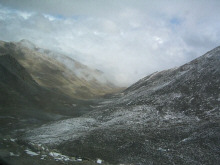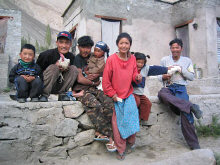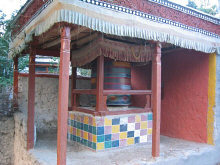
 View From Khardung La
View From Khardung La
With a flashlight in hand to light the way, I walked along Changspa Lane to the center of Leh situated at an altitude of 3505 meters with the world's highest airport set amidst the stark mountains of Ladakh, India's northernmost region bordered by Pakistan and what is now the Tibetan region of China.
It's a land filled with many of the world's "highest's" and on that morning, I was on my way to catch a bus over the world's highest motorable pass. I was early for the 5:30 a.m. scheduled departure and the bus didn't show up until seven. Mostly locals and a few foreign travelers filled the seats and on the way out of town we stopped for more passengers who camped in the aisle.
Riding a bus in Ladakh is like attending a rolling party. The driver cum DJ pops the cassette tapes into a player mounted onto the dash decorated with flashing lights and the Ladakhis pass around treats of snacks and candies.
We chugged uphill out of Leh, whipping around hair-raising switchback turns, until the bus stopped at a checkpoint. People got off the bus to answer the call of nature and buy snacks from tented shops. After an authority inspected our papers, we ascended into a white mist of snow. The man seated next to me pointed out strings of colorful prayer flags and said, "Highest gompa in the world." Gompa means monastery. Soon, I saw people posing next to the sign, "Khardung La, World's Highest Motorable Pass 5602 meters."
Our bus kept on rolling over the summit and descended along the road carved into the steep mountainside until it stopped behind a string of vehicles. We waited for the fragile road to be repaired by the always-employed crew and then passed over the rollercoaster of bumps that lifted me from my seat. The bus continued along the winding road to smoother conditions below.
Riding along the edge of a steep river canyon, I could see isolated villages dotting the terraced mountainsides in the distance. After another passport check, we reached Khalsar where we stopped and spread out among the restaurants and tea stands. I sat outside, slurped up noodles from a bowl of vegetable thukpa soup and sipped a chai (milk tea).
A rainbow of multicolored trucks lined the road waiting for their turn to cross over the pass. The bus dropped down into the expanding Nubra Valley and when we reached Sumur I got off. As the bus disappeared in the distance, I took a look around the vast sparsely inhabited landscape. "What am I doing here?" I thought. A man who had also gotten off the bus pointed me in the direction of a guesthouse.

 Nepali Family
Nepali Family
After a short walk, I entered through a steel gate. I negotiated a room, placed my dinner order for mo mos and set off to explore the area. The man seated next to me on the bus had told me of a nearby gompa I could visit that the Dalai Lama had recently stayed at in a house the monks had built specifically for that purpose.
It was a lovely walk along a small babbling stream lined with bright yellow seabuckthorn berry bushes. I discovered a stupa with colorful haloed Buddhas painted on a cracked cement wall and soon came upon my friend from the bus. He walked me up to the gompa and left me at its entrance. It was brilliantly painted white with red and gold. Inside, several of the doorways were surrounded with intricate vibrant patterns. I found a nice spot and sat absorbing the sounds of the nearby stream. When I left, I waved to a group of young novice monks and crossed a bridge where two children came running down to greet me. "One photo," they cried. The young girl and boy were very friendly and I noticed the novice monks watching as I took photos of them. The girl took my hand and led me up to her family's enclave of small rooms set around a courtyard. They invited me in for tea and biscuits.
The family was from Nepal, they told me as we sipped butter salt tea. The young girl sat beside me with her hand on my arm. We joked and laughed and took some more photos and then they made a rice wine called chang from powdered balls they purchased at the market in Diskit, the nearest town. Not bad, but not for me.
It was nearing dusk and one of the guys suggested I begin my walk back to the guesthouse before night fell. Along a small road through the village, I came upon a prayer wheel with Om Mani Padme Hum painted in Tibetan text. It has many meanings and is said not to be accurately translatable to English, but a rough literal translation is, "The jewel of the lotus of the heart," and as a mantra, it is said to purify and evoke compassion on the path to enlightenment. I gave it a spin and continued walking.
I listened to the ringing of the attached bell fade as the distance grew. "Julley," said a group of Ladahkis I passed and "Julley," I replied. If you should know one word in Ladakhi, it's "Julley" meaning "Hello, goodbye" or "How are you?" "I'm fine" and "Thank you, you're welcome" depending upon the inflection and situational context. The most popular song in Ladakh is the happy sounding Julley song. It's like the national anthem and the lyric, "Julley".
At the guesthouse, I sat beneath the canopy of a parachute with a French man wearing something like a smoking jacket enjoying a cigar. We were joined for a delicious dinner of mo mos (circles of dough wrapped around a filling of vegetables) and boiled baby potatoes by another man and woman who were also from France. The woman was the life of the party with her smiling eyes and lively conversation. She insisted on speaking in English so I could be included.

 Prayer Wheel
Prayer Wheel
I woke up early the next morning and feeling quite satisfied with my visit, decided to try to catch the bus back over the pass. It was the journey over the highest road that intrigued me most. I found everyone waiting at the roadside. I was lucky to get a seat when the bus finally showed up.
The transmission broke down about three times making it questionable whether we would make it to the peak or not. It reminded me of a story called, The Little Engine That Could, "I think I can, I think I can, I think I can… I know I can," and over the pass we went.